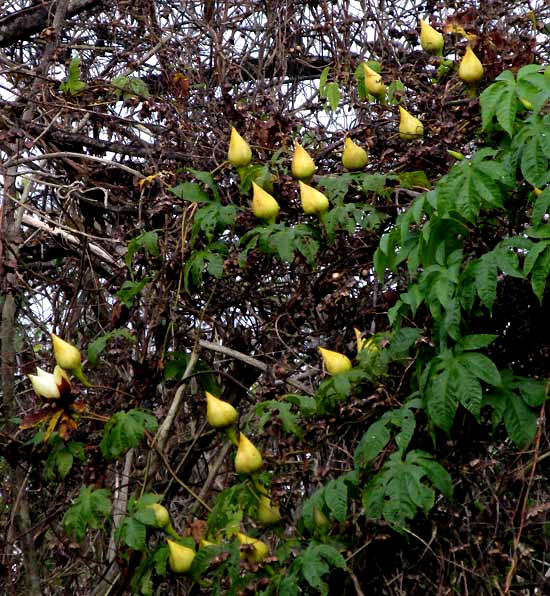Excerpts from Jim Conrad's
Naturalist Newsletter
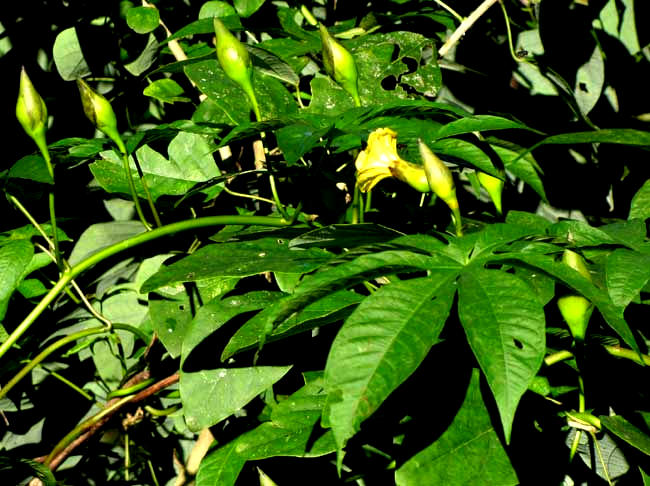
from the December 5, 2010 Newsletter issued from Hacienda Chichen Resort beside Chichén Itzá Ruins; limestone bedrock; elevation ~39m (~128ft), N20.675°, W88.569°; central Yucatán state, MÉXICO
YELLOW MORNING-GLORY
Next to the Hacienda's swimming pool a certain vine rankly overtops bushes below it, bearing yellow flowers, surprisingly large, teardrop-shaped fruiting capsules, and large, palmately lobed leaves, as shown above.
You expect a vine like that to be one of the many species of the Morning-Glory Family coloring our landscape right now, and the flowers' basic structure confirm that it really is a morning-glory. However, those oversized fruits next to the smallish flowers (2-1/3 inches or 6 cm across), and the deeply lobed leaves don't seem right. And not many morning-glory blossoms are yellow.
Most morning-glory-type vines we run into are members of the genus Ipomoea, so we associate the traits of that genus with the whole Morning-Glory Family, the Convolvulaceae. But, what's next to the swimming pool is no Ipomoea. It's MERREMIA TUBEROSA*, a whole other genus.
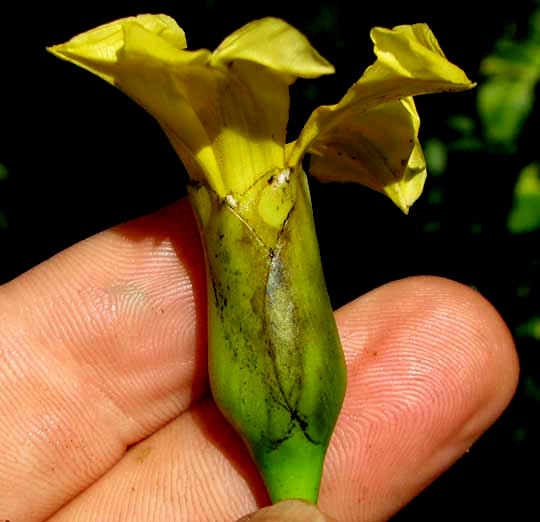
Above you can see a side view of the vine's flower showing normal sepals. It's more interesting if you break open a blossom and see what's un-morning-glory-like inside, as shown below:
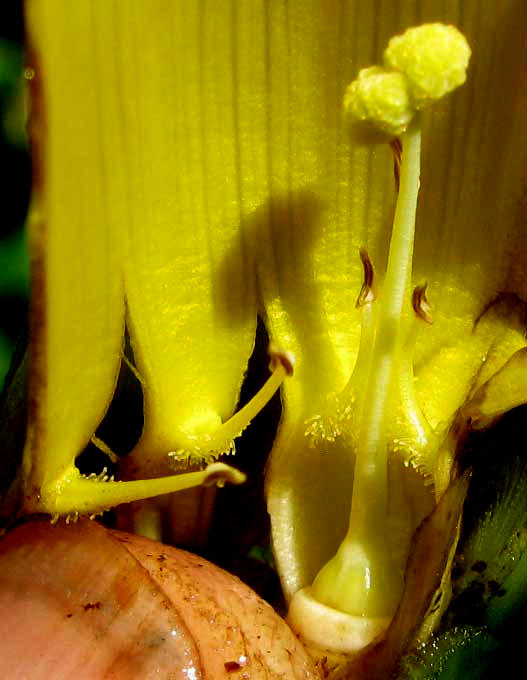
Actually, on the phylogenetic Tree of Life the genus Merremia lies very close to the morning-glory genus Ipomoea, so the single style arising from the ovary at the corolla base, the spherical stigmas, and stamens of unequal length all could be Ipomoea. However, notice that the anthers -- the banana-shaped, brownish items atop slender filaments -- are twisted. That's a big detail to taxonomists. Ipomoea anthers are straight, and ascending. Also Ipomoea has smaller, different kinds of fruits.
By the way, notice those "glandular hairs" at the filament bases. I don't know what their purpose is but a guess might be that where they all come together at the corolla's throat they impede nectar-seeking insects from entering the chamber below, but not the beaks of hummingbirds, who may be more efficient pollinators for this species. Below the hair-choked constriction, where the nectar is, an insect has nothing to do that would benefit the flower.
Merremia tuberosa is native to Mexico and Central America, but is grown as a garden ornamental throughout the world's tropics. It's escaped into the wild so often that it's considered a pantropical weed. Occurring so widely, it goes under many names. Some of the English ones are Woodrose, Spanish Arborvine, Hawaiian Wood-rose, Spanish Woodbine and Yellow Morning-glory.
Back in Querétaro we ran into another Merremia species, Merremia dissecta, with a showier flower with anthers much more conspicuously twisted.
from the February 26, 2012 Newsletter issued from Hacienda Chichen Resort beside Chichén Itzá Ruins; limestone bedrock; elevation ~39m (~128ft), N20.675°, W88.569°; central Yucatán state, MÉXICO
WOOD ROSE
You can see why the perennial, high-climbing vine sometimes called Wood Rose has that name below:

Of course those aren't roses, in fact they aren't any kind of flower, but rather they're a vine's thin-walled, capsular fruits subtended by much enlarged, dried-out, stiff, irregularly incised sepals. Inside each egg-size capsule, four black, fuzzy seeds are suspended not touching the capsule's walls, as shown below:

Three ¾-inch (18mm), black, fuzzy seeds are shown below:
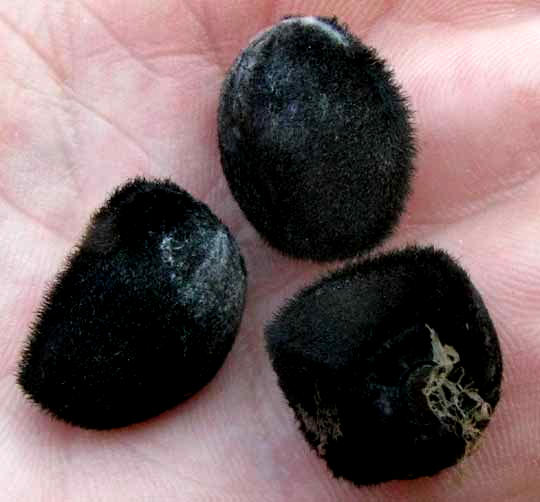
We've seen morning-glories with fruits similar to this, for example the white-flowered Operculina pinnatifida, whose smaller fruit and sepals are shown at www.backyardnature.net/n/10/101010oq.jpg.
So, we have a morning-glory, but it's not that one, so what is it? I had to ask my morning-glory expert, Ron in New Jersey, whose online name is -- believe it or not -- Ron_Convolvulaceae (Convolvulaceae being the Morning-Glory's technical name). Ron said it looked like Merremia tuberosa. We've already examined that species, when it was loaded with interesting yellow flowers in December {above}.
Why would a fruiting body evolve to look like a brown, woody rose? My guess is that its similarity to a wooden rose is incidental. Maybe the large, stiff sepals catch wind, causing the capsule to flap about on its slender stem, slinging seeds here and there. Maybe the seeds' hairs simply expose more surface area to the wind, helping the seeds sail farther.
The "wooden flowers" remain pretty for weeks. This is another species deserving to be much more widely planted in tropical gardens than it is.
from the January 31, 2016 Newsletter issued from Hacienda Chichen Resort beside Chichén Itzá Ruins, central Yucatán MÉXICO
WOOD ROSE FLOWER BUDS
Until now I hadn't realized until now how eye-catching the vine's very large flower buds can be, shown below:
